Foot epidermophytosis is a fungal disease, which is caused by a pathogen of dermatophytes that settle on a person's skin, from the genus trichophytons.
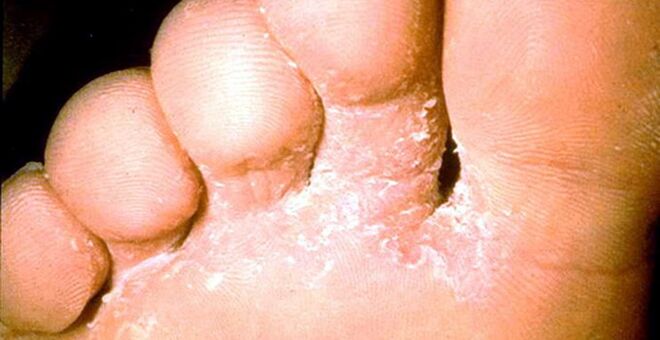
There are complex infections of the nails and skin in the feet and between the related toes.
Diseases of some professions that are in heat and high humidity, which are profitable for fungal development are very vulnerable to the disease - these are athletes, miners or people just not following their foot hygiene.
Reason for appearance
The main condition for the appearance of the disease is the skin infection, that is, a fungal dispute.This occurs in public places or directly contact with carriers through personal hygiene products, for example, shoes or socks.
The main places of collection of fungus are public shower, baths, sauna, locker rooms and so on.
In addition, encouraging conditions should be made for fungal development, facilitated by the following factors:
- increased moisture;
- Sweating;
- Long -term wearing uncomfortable shoes;
- low socks or shoes with insufficient ventilation;
- Professional activities (sports, work), when the feet are in continuous warmth and have water spread;
- vein thrombosis;
- Blood vessels;
- Diabetes mellitus;
- weak immunity;
- hard work;
- Pressure and nerve overstrain.
Fungus is not always activated when it is on the feet, as the body has its own protective function.The disease only occurs in the presence of pathology.
For example, socks squeeze blood vessels, and blood supply levels are reduced, or feet are always warm with high moisture and reduced skin acidity, creating good conditions.
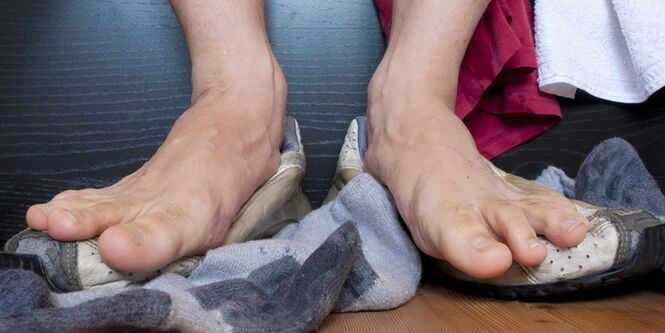
This is also facilitated by stress and hard work that reduces body protection against any pathogen.
Symptoms and stages of fungus
The disease is characterized by the form and stage of the epidermophytosis.The main symptoms of the features -all forms are peeling and redness of the skin between the toes and feet.There are four stages of the disease:
Deleted or lightweight stage
Between the toes, the focus of the skin peels off, the feet are clean.Patients practically do not feel uncomfortable or unpleasant symptoms.
Squamous-hyperkeratatic stage
At this stage, the disease is more clearly indicated.On the fingers and between them, as well as on the side of the feet, there is a brown or bluish leather seal.
The skin peels off with a dry scale.The patient has increased the dryness of the foot.White and yellow shapes may look similar to corn.
The infected place emits itchy.The unpleasant odor comes from the feet.
The intrigin level
The feet are always wet and charming.Between the toes there is an edema equation.White or yellow bloating appears.
The skin peels off the entire surface of the feet and toes.There may be wounds, cracks and erosion, which is sometimes bleeding, if damaged.
Patients experience persistent discomfort, itching or poor pain, especially when walking.Skin detachment is important, as well as seals.
Dyshidrotic stage
All over the surface of the foot and between the toes, the formation that resembles a bubble appears.They collect the liquid that melts with damage to the bubble wall.
Subsequently, swelling and inflammation of the skin may occur.The feet and fingers are always itchy, and the feet get a strong odor that cannot be suppressed with soap or other means.
Complication
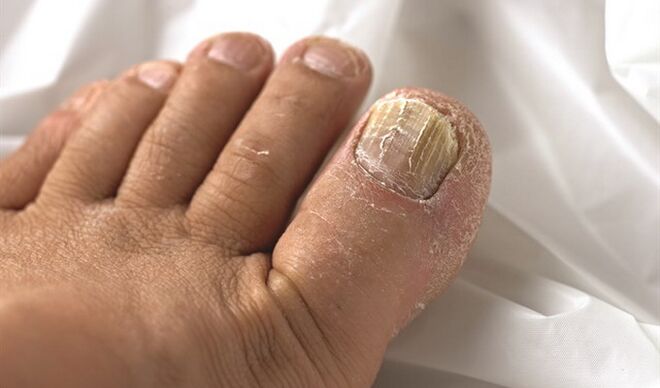
In addition, the disease falls on the nails that gradually turn yellow, then deform and peel.This occurs in each third case of the epidermophytic, if tightened with treatment.
In the most advanced cases, the fungus "throws" to other parts of the body, causing the appearance of stains on the skin, allergic reactions or other pathologies.
Treatment
To treat the disease, you must contact my major.Various tests and studies will be conducted based on appropriate treatment.
Therapy is intended to destroy fungus.For this, funds are used for internal and local use, moreover, at the same time.
Medication
Fungal treatment occurs at home and lasts, depending on the stage, from 2-3 months to 1 year.To suppress fungal activity from the inside, use 2-Chlorin-4-Nitrophenol drugs.
In parallel, the affected area should be treated with local medicines (creams, gels, ointments):
- Clotrimazole.
- Tolnaftat.
- Mikonazole.
- Terbinafine.
- Econazole nitrate.
- Naphthyfin hydrochloride and others.
When the secretion and inflammation of the purulent appear, itraconazole is usually prescribed.A systematic approach allows you to more effectively deal with infections.
The choice of medicine and treatment is performed by the attending physician based on the clinical picture.
The recovery of the people
Traditional medicine is used as an additional measure of the fight against fungus, but not free.
People's recipes can only help in the early stages of the disease.Consider some of them:
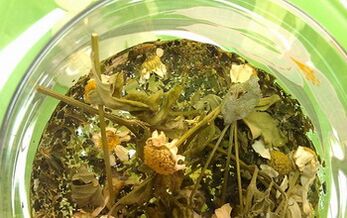
- Vaseline and salicylic acid.For 1 teaspoon of petroleum jelly, half of aspirin tablets or salicylic acid are taken, mixed and used for areas between the toes, slightly rubbing.This will help stop the spread of fungus and relieve unpleasant symptoms.
- Boil herbs.The following herbs that have antifungal and anti -anti -anti -anti -anti -anti -effects should be taken: Chamomile, Horsetail, Wort St.John and eucalyptus leaves.All herbs are taken in the same amount (1 teaspoon per 0.5 l of water).The water was boiled and boiled for 10 minutes, after which it also insisted for 30 minutes.In boiling, the feet jump, gradually add hot water.
- Sea buckthorn oil.Cotton swabs are moistened in oil, eliminating the affected area.This is a good antiseptic that relieves pain, itching and inflammation.
- Soda, salt and soap.Inside the hot basin, a piece of laundry soap and 1 tablespoon of soda and dissolved salt.The footing procedure is performed daily, preferably before bedtime.This will help to cleanse the skin from the keratin and will further affect the effectiveness of the drugs that penetrate further into the finger and leg tissue.
- Boric acid.For treatment, a solution (2%) of boric acid is used, which wipes the feet with cotton swabs.This is a powerful antiseptic for fungus.However, you should be careful and not perform the procedure too often so as not to burn chemicals.
Shoes and underwear
In addition to direct treatment, you still need to monitor the condition of the shoe and linen.This is important, because therapy should not be meaningful if it is ignored by hygiene.
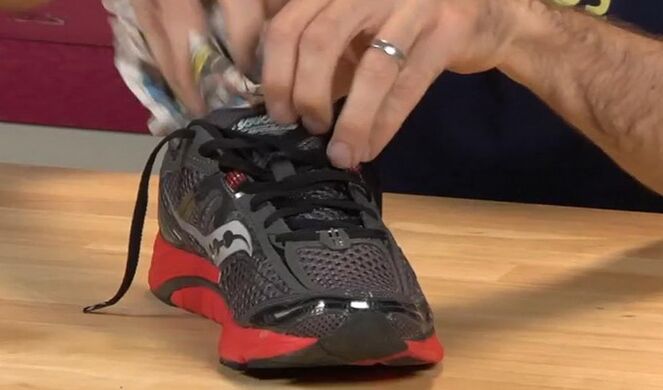
The shoes should always be dry, and the socks can be changed daily.It is useful for treating daily shoes with formalin for disinfection.
After performing the water procedure, the feet are rubbed with a clean dry towel, especially between the toes.Then immediately use the medicine cream or ointment prescribed by the doctor.
With increased sweating, boiling or absorption of oak bark, as well as regular vinegar, help.
The main thing is to keep your feet dry, as moisture is a good environment for fungal development.
Prevention
There are several precautions aimed at preventing relapse or infection with fungus on the feet:
- Wash your feet several times a day, wiping them dry;
- You cannot use other people's socks, shoes or towels;
- Daily shoes should always be dried before use;
- In public, use slippers or other shoes, and then use disinfectant to reduce the risk of infection;
- Shoes should be comfortable and do not cause sweating;
- regularly visit doctors for preventive examinations for any disease;
- eat properly;
- Reduce the use of alcohol and sweet foods.
Conclusion
Epidermophytosis is a very unpleasant disease, as it damages the appearance of the foot and causes an unpleasant odor.
The feet are always sweating and starting to smell bad.This disrupts one's normal life and shackles.
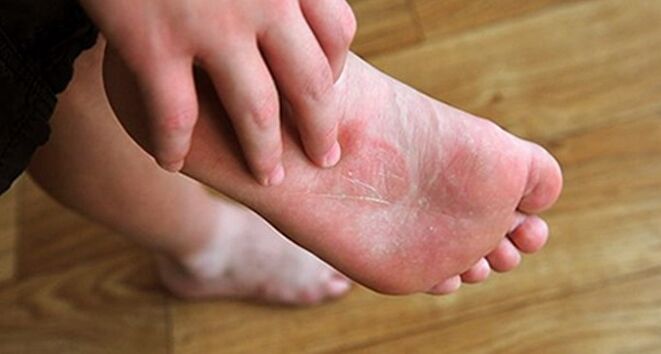
First and foremost, the disease affects personal life and, therefore, treatment should start at the first symptom, given the risk of infection with other people's fungus.
In the early stages, the disease is easy to therapy, and recovery occurs after a few months.However, in advanced circumstances, this can take a year or more, so no need to postpone.


















